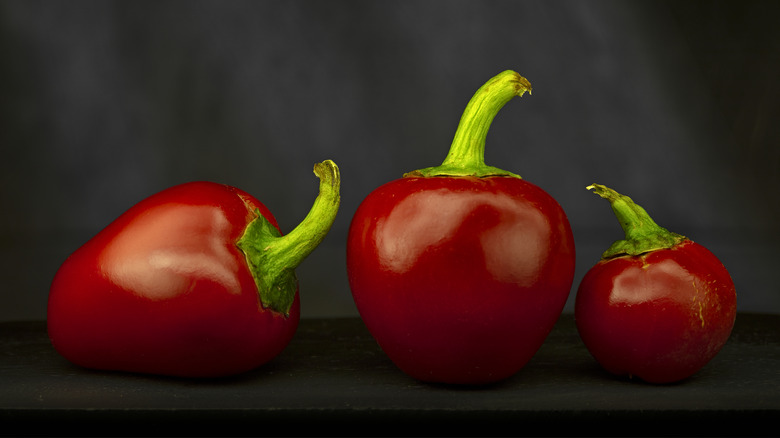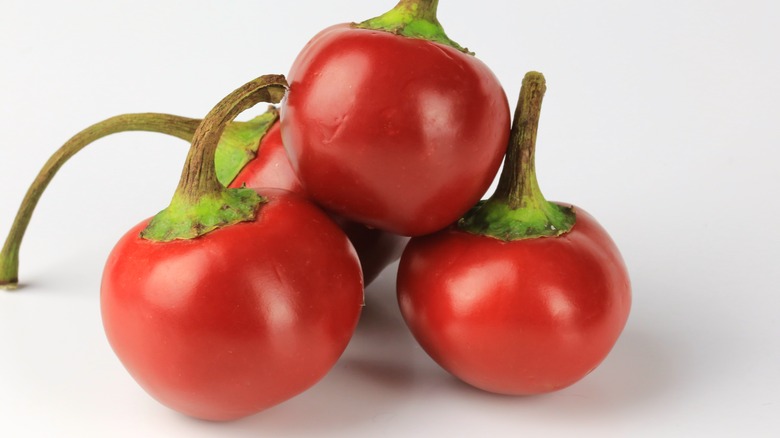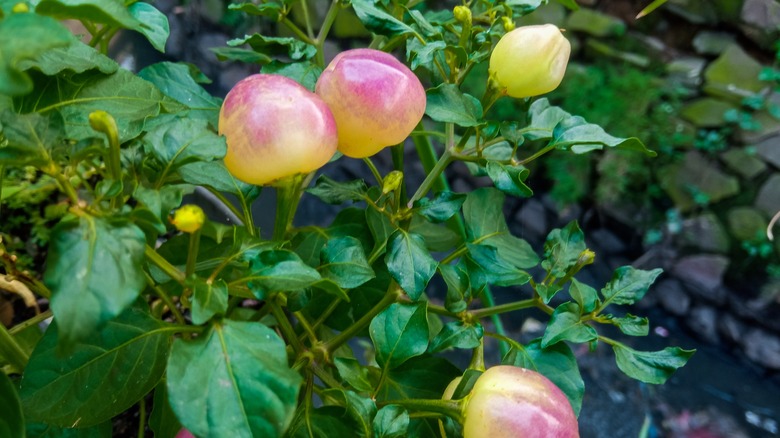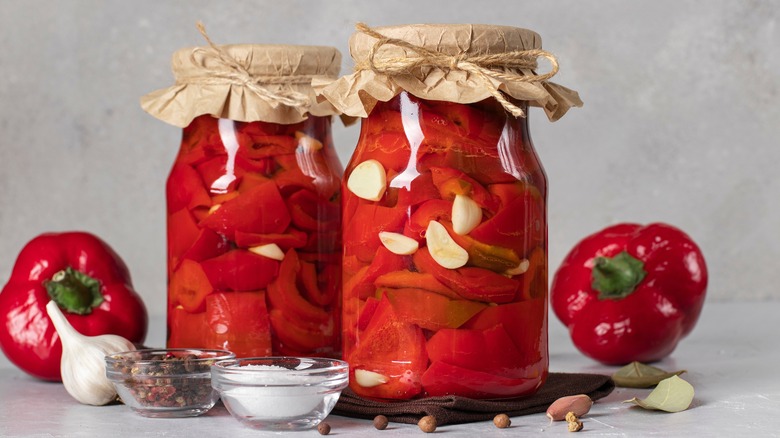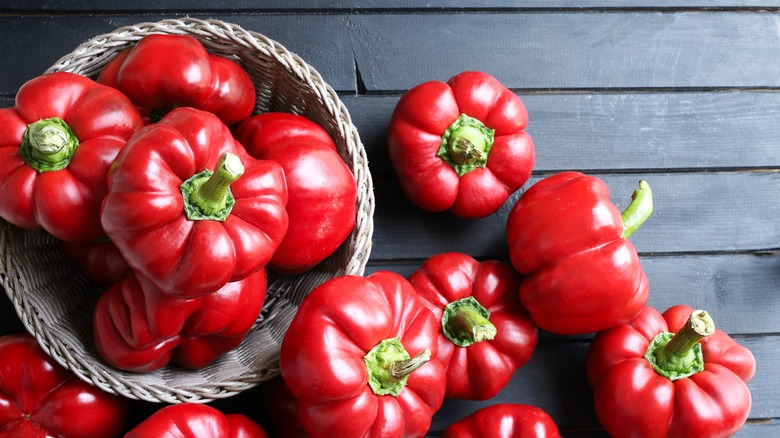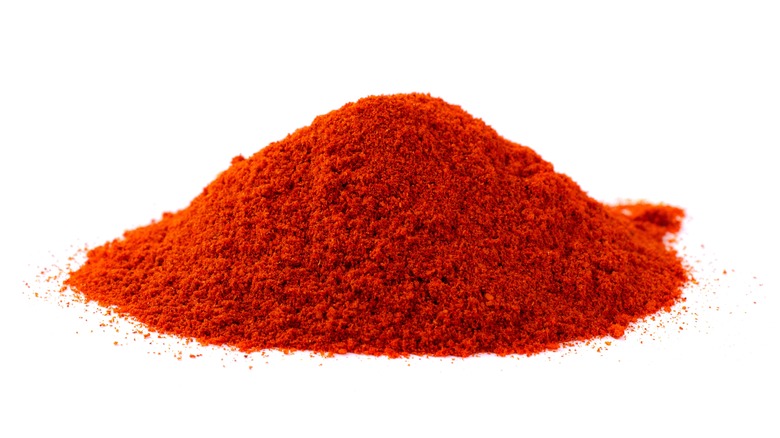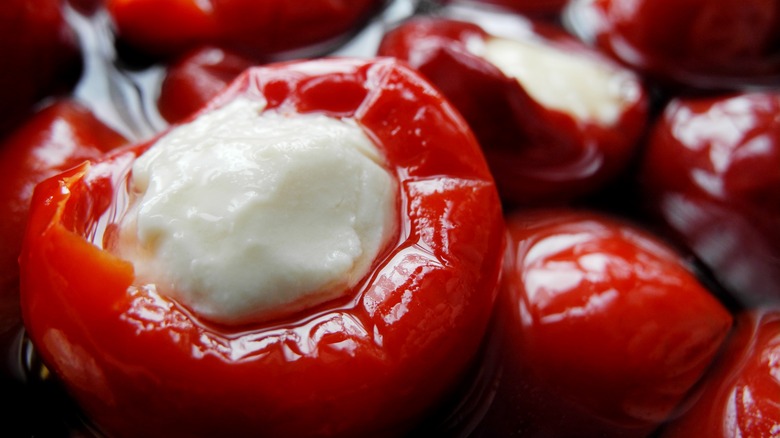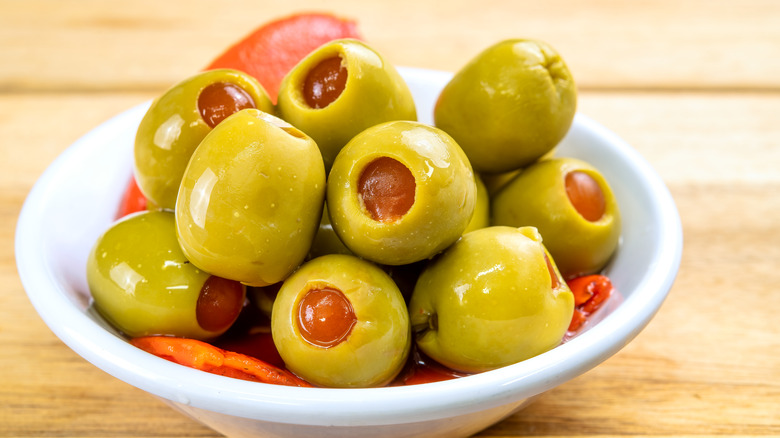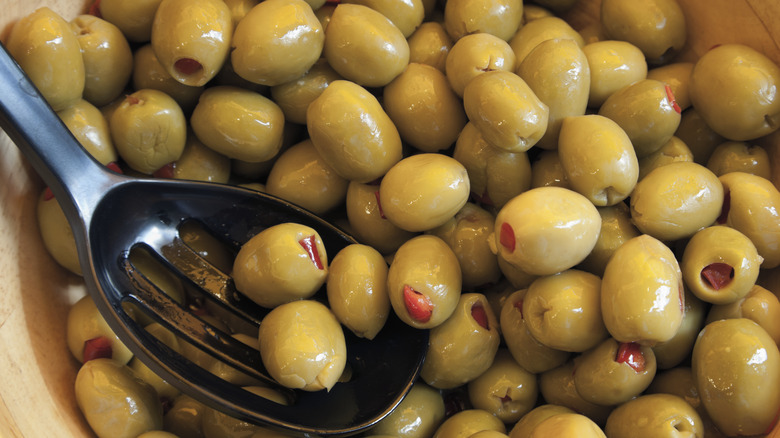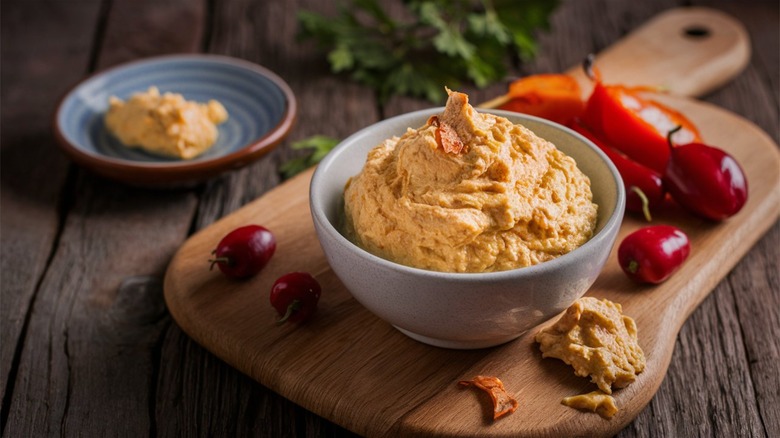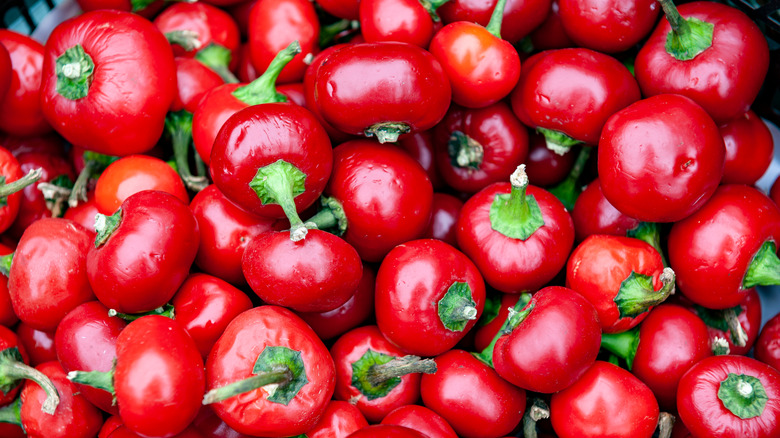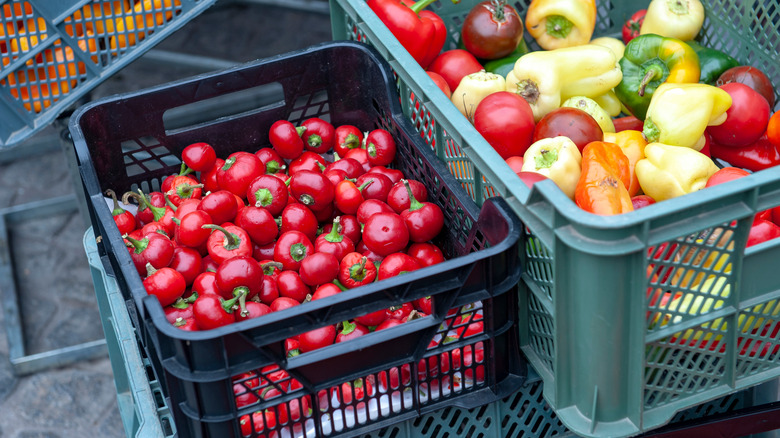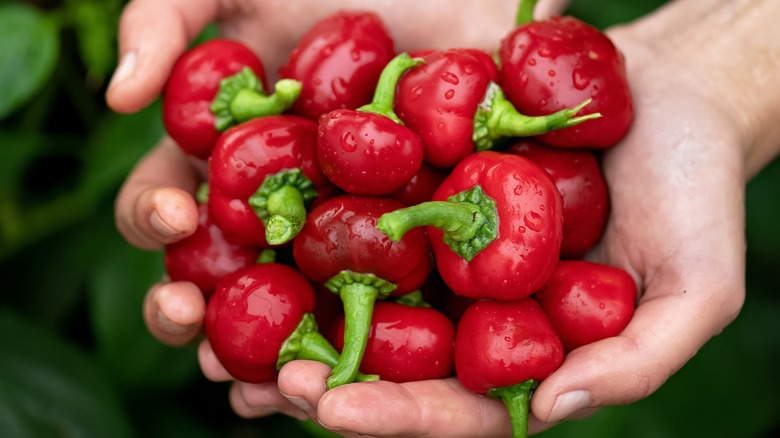What Are Pimentos, And Who Decided They Should Be Stuffed In Olives?
You've probably encountered pimentos without even knowing it. The brightly colored vegetables are often found diced and mixed into cheese dips or tucked neatly into pitted green olives. Yes, that familiar red filling in your olives is actually a pimento pepper. While this might be its claim to fame, the pimento is so much more than just a pretty garnish. It's a highly versatile vegetable that can lend itself to many forms and uses in the kitchen.
If you're not already taking advantage of pimentos, there's no better time to start than the present. The peppers add flavor and color wherever they go, whether you toss them into a salad or add them to soups, sandwiches, or pasta. Small but mighty, these peppers enhance any recipe but are also delicious all on their own. If you're not sure where to begin, we've put together a guide that covers everything you need to know about pimentos, including their history, taste, and uses as well as where to get your hands on some for yourself. This comprehensive guide will hopefully inspire you to experiment with pimentos beyond the bits you get when snacking on some olives 一 though that is always a worthwhile way to enjoy them.
What are pimentos?
Pimentos (part of the Capsicum annuum species) are a type of chili pepper, recognizable for their round or heart-shaped appearance. These peppers are on the small side, typically only measuring about 1 ½ inches across. Also called cherry peppers, pimentos come in varying shades of red, green, and yellow, with red being the most common hue. The peppers are a member of the Solanaceae family, also known as nightshades. But don't worry. Pimentos are perfectly safe to eat. While some plants in the Solanaceae family are poisonous, other members, such as potatoes, tomatoes, and eggplants, are completely edible 一 and delicious.
Like other peppers, pimentos fare best in hot weather. Pimentos grow in the warmer seasons and are usually ready for harvest in the summer and fall when they reach peak maturity. Depending on the variety, pimento plants can grow to be large and produce hundreds of peppers per plant, while smaller plants are well suited for container gardening.
The history of pimentos
Though enjoyed today in many cuisines, pimentos originate from the Americas. The chili pepper's ancestors evolved in South America and eventually spread throughout Central and North America, where they were domesticated by indigenous populations in Mexico more than 6,000 years ago. When Christopher Columbus sailed to the New World, he was impressed with the flavorful chili pepper and brought seeds back with him to Spain. Highly popular, the peppers then made their way across Europe, Asia, and Africa.
In Spanish and Portuguese, the name "pimento" comes from the Latin word for coloring or pigment. Today, in both languages, "pimento" or "pimiento" can describe any type of pepper. However, in English, the word "pimento" has undergone several changes in meaning over the years. Prior to the 1880s, pimento was actually the name for a type of unripe berry, commonly used to make allspice seasoning. However, recipes began using the word "pimento" to refer to sweet peppers, and it caught on. The name gained popularity by the start of the 20th century, and the rest is history.
Taste and spice level of pimentos
Pimentos are juicy peppers that are well-loved for their sweet taste. They have a pleasant fruity flavor that isn't too overpowering yet still carries its weight in any dish. Though their bright red color and size might make you think they pack a lot of heat, pimentos are delightfully mild 一 though there are spicy varieties. Pimentos typically score between 100 and 500 units on the Scoville heat rating system, meaning that you won't need to try to increase your spice tolerance to enjoy these peppers. In comparison, jalapeño peppers fall within the range from 2,500 to 5,000 Scoville Heat Units.
The sweet, mild flavor of pimentos is very similar to that of red bell peppers, which is no surprise given that the two peppers also share the same scientific name and family. However, pimentos are typically sweeter and more aromatic than their larger cousins. Still, the two peppers can be used interchangeably in many recipes, and both can be eaten either raw or cooked.
Health benefits of pimentos
On its own, the pimento is a nutritious vegetable that provides many health benefits. The pepper is high in vitamin C, which helps the body produce collagen, heal wounds, and absorb iron. Pimentos are also a good source of vitamin A, which fortifies the immune system, supports healthy vision, and promotes reproductive health. The B vitamins in pimentos (B2, B3, and B6) help support growth, energy levels, heart and brain health, metabolism, and more. Last but not least, pimentos also contain vitamin K, which is essential to helping the body form blood clots and heal wounds.
In addition to vitamins, pimentos also provide the body with minerals like iron and copper. Iron is essential to delivering oxygen throughout the body. Insufficient iron can lead to anemia, which can cause fatigue and a weakened immune system. Vitamin C helps the body absorb iron, meaning that pimentos are a two-for-one addition to any meal. Similarly, copper supports immune system health and helps the body produce red blood cells. Altogether, incorporating fresh or cooked pimentos into your diet can be an excellent way to improve your vitamin and mineral intake. However, be aware that pickled or otherwise processed peppers may contain high levels of sodium.
Pimentos as pickles, paprika, and more
Pimentos come in many shapes and forms at the store. While you may sometimes find fresh pimentos in the produce section, you'll most likely see them pickled or preserved in jars or cans. Some pimentos are packed with vinegar, oil, salt, and seasonings, while others are submerged in only water. When choosing pimentos, make sure to always read the nutrition label before purchasing, as some prepared peppers may contain unwanted spices or seasonings that can affect their flavor. For those looking to minimize sodium and additives, it's a good idea to opt for water-packed pimentos with few extra ingredients.
You can also find pimentos in the spice aisle. Far from the hottest pepper out there, pimentos are often dried and ground up to make sweet paprika. Paprika can be made from various types of peppers, depending on the desired flavor and heat level. The most common variety, sweet paprika, can include pimentos along with other mild Capiscum annuum peppers. With there being so many ways to enjoy pimentos, it's easier than ever to incorporate them into your cooking.
Common uses for pimentos in the kitchen
Like bell peppers, pimentos are delicious raw, sliced up, and dunked in your dip of choice. Diced pimentos can also add a fresh-tasting crunch to salads or chunky salsas. Alternatively, you can roast or grill pimentos and enjoy them as a side or topping for any meal. Cooked pimentos add a burst of flavor and color, working well as pizza and sandwich toppings or mixing them into pasta. You can also puree roasted pimentos to make a tasty spread or the base of a sauce or stew. Yet another way to enjoy pimento peppers is to stuff and bake them. Cheese, meat, veggies, and grains all make good fillings.
If fresh pimentos aren't available, pickled or preserved pimentos are also tasty additions to any dish. Pickled pimentos can contribute a sour, salty flavor, making them well-suited in salads, sandwiches, or other cold dishes. You can also blend them with other vegetables and seasonings to make homemade relish or salsa. Ultimately, pimentos can be used anywhere you might reach for a bell pepper.
Why pimentos are stuffed into olives
Now that you're familiar with pimentos themselves, we can answer your most burning questions about the peppers: how and why they're stuffed into olives. To begin with, the origin of pimento-stuffed olives is shrouded in mystery to this day. What we do know is that the delicacy emerged in the Provence region of France in the 1700s. The practice likely developed as a way to cut the bitter, salty, and pungent flavor of green olives. The sweet, mild taste of the pimento pepper complements the olive's stronger palate, resulting in a perfectly balanced bite.
Up until recent decades, all olives were stuffed by hand with pimentos. As you can imagine, this process was time-consuming and labor-intensive. In 1962, a Spanish company by the name of Sadrym invented an automatic stuffing machine. Today, most olives on store shelves are likely machine-stuffed, though many higher-end olives are still hand-filled. Rather than a whole piece of pimento, the olives usually contain diced or pureed peppers for ease of stuffing. Delicious as well as visually striking, pimento-stuffed olives are a welcome appetizer or garnish for just about any meal (or fancy cocktail).
Are pimento-stuffed olives healthy?
Olives and peppers are both known for their health benefits, so you might presume that when together, the two ingredients are good for you. However, pimento-stuffed olives can run very high in sodium, mainly due to how the olives are prepared. Fresh off the branch, olives are bitter and inedible. To remove this bitterness, olives undergo processing that can include salt curing, lye curing, or fermentation in salt water. Once this process is completed (and any fillings are added), the olives are then packed in either brine or oil.
Anyone who's ever had an olive can attest to its salty taste. It's important to note that the U.S. Food and Drug Administration advises limiting your daily sodium intake to less than 2,300 milligrams. A serving of six olives can contain about 20% of that value. For some brands, the serving size is as little as one olive. Always make sure to read the nutrition label of any product and follow the manufacturer's serving size guidance. Consuming too much sodium can cause high blood pressure, which can increase your risk for a heart attack, stroke, or kidney disease. Of course, everyone has different dietary needs, and most people don't need to avoid stuffed olives entirely. Olives are a good source of vitamins and monounsaturated fat, which is the healthy kind. As with most things, moderation is key.
Pimento cheese and how it's enjoyed
Other than stuffed olives, the tiny pepper's other major claim to fame is pimento cheese, which is well-suited in a ham sandwich. A staple in Southern cuisine, pimento cheese is a spread that contains cheddar cheese, pimento peppers, and mayonnaise. Other common ingredients can include cream cheese, Worcestershire sauce, garlic, onions, and spices such as cayenne and paprika. Pimento cheese emerged in New York City in the late 1800s and originally consisted of just cream cheese and canned pimentos. As canned pimentos were still a luxury item, farmers in Georgia began growing the peppers themselves. Over the years, mayonnaise replaced cream cheese and shredded cheese became a main ingredient, solidifying the recipe as we know it today.
Pimento cheese sandwiches are the most popular way to enjoy the spread. Known as "the caviar of the South," pimento cheese is a common dip for crackers, bread, or fresh veggies. However, you can also find pimento cheese in deviled egg and biscuit recipes or holding together layers of lasagna. Other creative uses include stuffing peppers and adding it to casseroles, burgers, macaroni and cheese, or mashed potatoes.
Common varieties of pimentos
If you thought there was just one type of pimento, think again. There are many different varieties, though some are more common than others. In the U.S., two types of pimentos are commonly grown. The first has a round, slightly flatter shape like a pumpkin 一 Early Sweet Pimiento and Sunnybrook are two cultivars in this category. The second is more cone-shaped in appearance, with Perfection and Sweet Meat Glory being two examples of this type.
The Perfection Pimento, a highly popular variety, was cultivated in the early 1900s by Samuel Riegel and his family who worked as farmers in Georgia. The Riegels imported seeds from Spain and experimented with the plants until they produced the aptly named sweet peppers we know and enjoy today. Other common pimento varieties include the lobed Red Ruffled pimento, the bright red Lipstick pimento, and the multicolored Trinidad pimento. Floral Gem and Santa Fe Grande are two cultivars that pack a bit more heat than most pimento types.
Buying pimentos
Unless you live in an area where they're grown, you may have difficulty in tracking down fresh pimento peppers. In the summer and fall, you may be able to find pimentos in the produce section at some grocery stores. Otherwise, your best bet is to check for them among the hidden gems at your farmers market. While each one is different, farmers markets typically sell produce that isn't available at most grocery stores. If you do come across fresh pimentos, note that they likely won't be available all year round, so make sure to stock up. When buying pimentos, select ones that feel firm and heavy. For most varieties, you can't go wrong picking pimentos that display a rich red color.
If you're craving pimentos out of season, most stores carry some form of packaged or processed peppers. Check the deli section and the jarred and canned food aisles. You might have luck in your store's olive, pickle, and relish section. While prices may vary by location, we spotted several places with pimentos in stock: Purchase fresh pimentos at Safeway for $7.99 per pound, a 4-ounce jar of sliced water-packed pimentos on Amazon for $4.19, or a 16-ounce jar of pickled pimentos at Walmart for $6.41.
How to store pimentos
If you buy fresh pimentos, store them in the crisper drawer of your refrigerator to ensure they last for as long as possible. Stored in the fridge, pimentos should stay fresh about a week. After that, the peppers may lose flavor and firmness, and eventually, mold may appear. If you're not able to eat all your pimentos in time, you can always pickle, can, freeze, or dry the extras. This way, you can enjoy pimentos even after their season is over.
For processed or packaged pimentos, check the manufacturer's instructions for storing the peppers once opened. Most pimentos sold in jars can last up to nine months in the refrigerator. To extend their shelf life, place any unfinished peppers to an air-tight container along with their original liquid and store them in the fridge. Alternatively, just like with fresh pimentos, you can also freeze your packaged peppers. Simply separate them into freezer-friendly containers or plastic bags and use them as needed.
